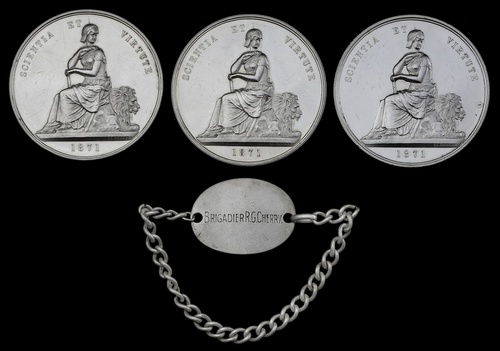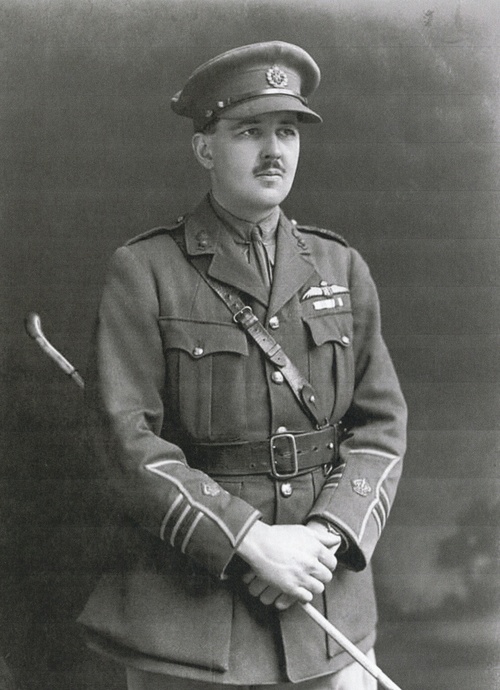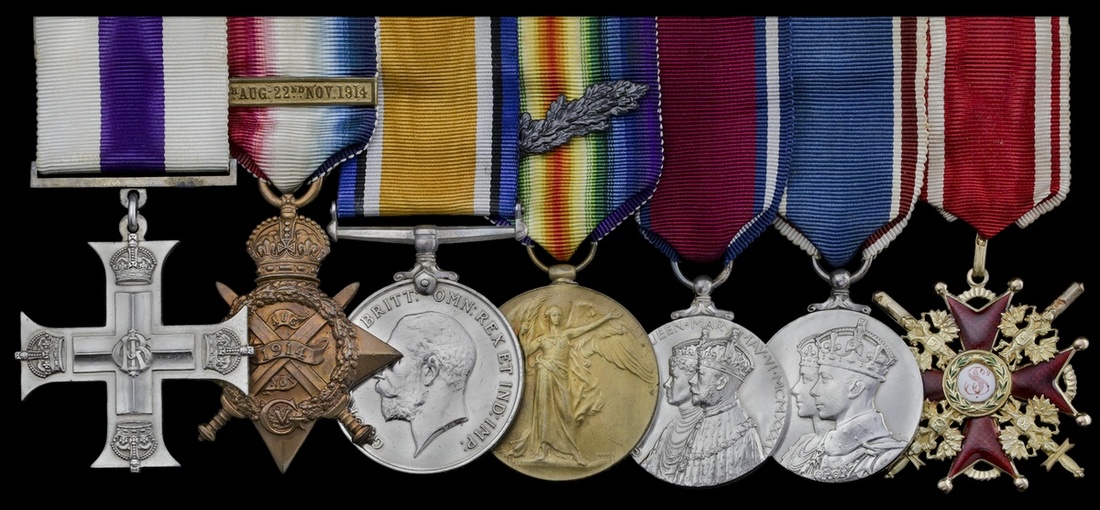Auction: 19002 - Orders, Decorations and Medals
Lot: 403
A very fine Great War Squadron C.O.'s M.C. and Russian Order of St. Stanislaus group of seven awarded to Lieutenant-Colonel R. G. Cherry, Royal Flying Corps, later Brigadier, Royal Artillery, whose resolute command during the Battle of the Somme included a fine prize for the Squadron 'bag', namely the shooting down of famous German ace Max Immelmann
Military Cross, G.V.R.; 1914 Star, with copy slide clasp (Lieut. R. G. Cherry. R.F.A.); British War and Victory Medals, with M.I.D. oak leaf (Major R. G. Cherry. R.F.C.); Jubilee 1935; Coronation 1937; Russia, Order of St. Stanislaus, 3rd Class breast Badge with Swords, by Dmitry Osipov, 40mm, gold and enamel, maker's name to reverse, gold marks to sword blades and loop, mounted as worn, good very fine (7)
M.C. London Gazette 1 January 1917. The original recommendation states:
'For exceptional good service and continued devotion to duty during the last six months. As officer commanding a fighting Squadron he has, by the personal interest he always takes in the details of his command and the example he has shown his pilots in the air, helped to gain the moral ascendancy over hostile aircraft that his Squadron undoubtedly possesses.'
Russian Order of St. Stanislaus, 3rd Class London Gazette 15 February 1917. Recommended on 18 August 1916.
Robert Graeme Cherry was born on 22 March 1886 at Cawnpore, India, the son of Colonel H. A. Cherry, Northumberland Fusiliers. Educated at Charterhouse and the Royal Military Academy, Woolwich, Cherry was commissioned 2nd Lieutenant in the Royal Artillery on 7 October 1907. Serving initially in the rank of Lieutenant, Cherry served in France from 10 August 1914 and was clearly in the thick of it. Present in the action which cost the life of Lieutenant R. L. Spreckley, Connaught Rangers, on 14 September 1914, he wrote to his father recalling the action (Hampshire Telegraph 2 October 1914, refers):
'Spreckley earned the V.C. twice over before he was killed. He was hit in the leg at the critical moment, went back, got dressed, and hobbled up to the firing line in the woods, cheering his men on. He was hit again, and did ditto, getting back just as his fellows were breaking. He rallied them, and drove the Germans on, only to be shot when the situation was saved.'
After the initial actions on Mons, Cherry was appointed Aide-de-Camp to the Commander of the 2nd Division, Major-General Charles Monro from 7 October-18 December. Advanced Captain, Cherry returned home for leave at Christmas and was back in France from January-April 1915 - he was awarded a 'mention' to boot (London Gazette 22 June 1915, refers). Having developed a personal interest in aviation, he gained his Royal Aero Club Certificate on a Farman bi-plane (No. 1253) at the British Flying School, Le Crotoy on 30 April.
Further training at Upavon gained Cherry his 'Wings' and on 25 September he was sent to Montrose, Scotland to become a founding member of No. 25 Squadron. The fighter-reconnaissance unit moved to Barnham, Norfolk on 31 December and ended up flying F.E.2b's by February 1916.
Deployed to the Royal Flying Corps Headquarters at Saint-Omer, France on 20 February, they were initially tasked with intercepting German aircraft, operating in the routes taken by the Luftstreitkräfte on their way to raid England. Gaining rapid advancement, Cherry was promoted Major and Squadron Commander on 16 March, a position he held for over a year.
On 1 April, the Squadron relocated to Auchel, operating alongside Nos. 18 and 27 Squadron - in support of the British 1st Army near Fromelles and Souchez. In June 1916, in preparation for the Somme Offensive, the Squadron had its strength bolstered to 18 machines, 20 pilots and 18 observers, all under the watchful command of Cherry, who was himself growing in confidence and experience. In the prelude to the battles which raged, No. 25 flew reconnaissance and bombing missions behind enemy lines. It was on 18 June that Corporal James Henry Waller, and his pilot 2nd Lieutenant George Reynolds McCubbin, shot down the famous German ace Max Immelmann - with well-deserved decorations following for both. Their 'kill' occurred during No. 25 Squadron's second encounter with Immelmann that day, after he previously shot down Lieutenant Rogers for his penultimate victory. Immelmann, flying a Fokker E.III, engaged No. 25 Squadron over Lens and shot down Lieutenant J. R. B. Savage before closing in on McCubbin's F.E.2b, whose gunner, Waller, opened fire and shot him down.
For his exemplary command of the Squadron, Cherry finished the year with a well-deserved M.C. to go with his Russian decoration.
Returning home on 4 June 1917, Cherry was advanced Temporary Lieutenant-Colonel and posted to Eastern Wing HD in August 1917. Injured in a flying accident on 29 November, his final posting was with 50 Wing from 25 February 1918 and thence 13 Group from 16 November.
Resigning his commission in the Royal Air Force on 12 September 1919, Cherry returned to the Royal Artillery and was on Staff duties in India during the 1920s. An Instructor at the Gunnery School of Artillery from 7 November 1928-7 November 1931, he won three Silver Medals in the Duncan Essay Competition in 1928, 1929 and 1932, being promoted Brigadier in March 1938. Cherry was finally placed on the Supernumery List on 22 March 1941; sold together with three Royal Artillery Institution Silver Duncan Essay Prize Medals, 48mm, inscribed 'Major R. G. Cherry. M.C., R.A., 1928.', 'Major R. G. Cherry, M.C., R.A., 1929' and 'Major (Bt. Lieut. Colonel) R. G. Cherry, M.C., R.A. 1932', his silver identity bracelet, engraved and neatly struck through 'Major R. G. Cherry. Royal Flying Corps', and the obverse subsequently 'Brigadier R. G. Cherry', together with copied research.
For the recipient's miniature dress medals, please see Lot 419.
Subject to 20% VAT on Buyer’s Premium. For more information please view Terms and Conditions for Buyers.
Sold for
£3,500
Starting price
£2100
Sale 19002 Notices
No. 25 Squadron, as stated, were based at Auchel which is north of the Somme Battlefields in the First Army Front.









